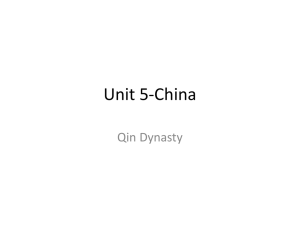Protecting the Northern Border
advertisement
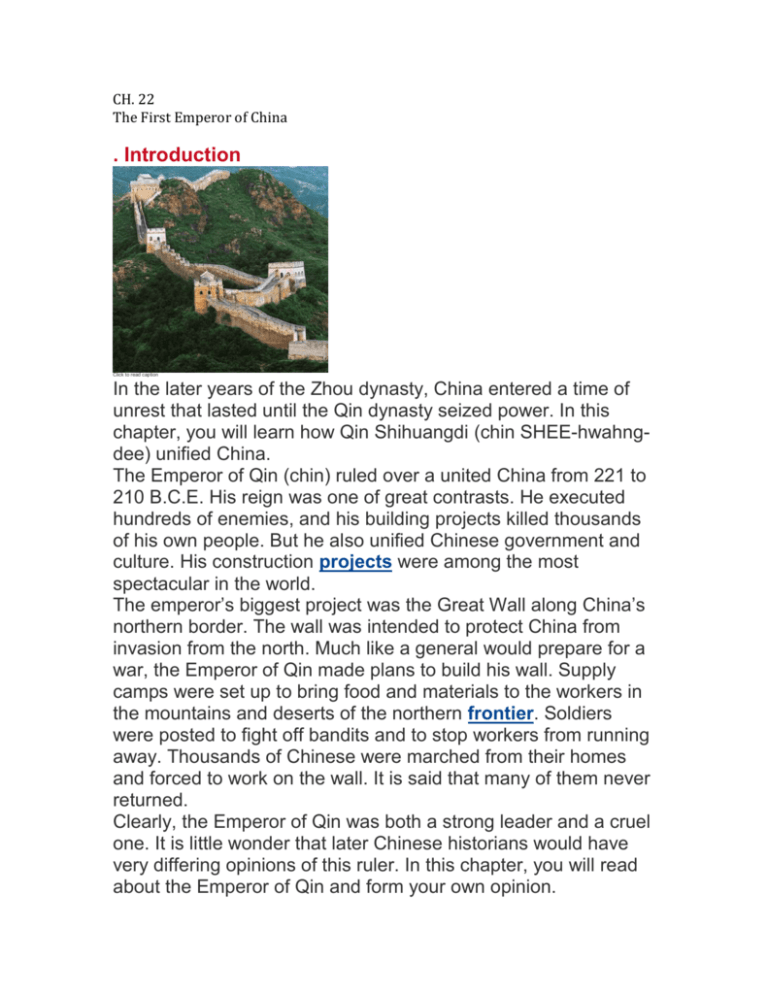
CH. 22 The First Emperor of China . Introduction Click to read caption In the later years of the Zhou dynasty, China entered a time of unrest that lasted until the Qin dynasty seized power. In this chapter, you will learn how Qin Shihuangdi (chin SHEE-hwahngdee) unified China. The Emperor of Qin (chin) ruled over a united China from 221 to 210 B.C.E. His reign was one of great contrasts. He executed hundreds of enemies, and his building projects killed thousands of his own people. But he also unified Chinese government and culture. His construction projects were among the most spectacular in the world. The emperor’s biggest project was the Great Wall along China’s northern border. The wall was intended to protect China from invasion from the north. Much like a general would prepare for a war, the Emperor of Qin made plans to build his wall. Supply camps were set up to bring food and materials to the workers in the mountains and deserts of the northern frontier. Soldiers were posted to fight off bandits and to stop workers from running away. Thousands of Chinese were marched from their homes and forced to work on the wall. It is said that many of them never returned. Clearly, the Emperor of Qin was both a strong leader and a cruel one. It is little wonder that later Chinese historians would have very differing opinions of this ruler. In this chapter, you will read about the Emperor of Qin and form your own opinion. 2. Creating an Empire Click to read caption China’s first emperor began life as Prince Zheng (jung) of the royal family of the state of Qin. He was born in 259 B.C.E., near the end of the Warring States period. In 256 B.C.E., Qin rulers took over the state of Zhou, ending the Zhou dynasty. Ten years later, 13-year-old Prince Zheng became king. Sometimes called the Tiger of Qin, Zheng was quite an ambitious man. He used military might, spies, bribery, and alliances to conquer the remaining rival states. His empire became far larger than the kingdoms of earlier dynasties. In 221 B.C.E., he gained control of all of China. He decided then to take a new title, Qin Shihuangdi, or First Emperor of Qin. As a ruler, the Emperor of Qin was greatly influenced by Legalism. Legalists believed in strict laws, harsh punishments, and a strong central authority. The emperor adopted these ideas. To avoid threats from powerful lords, he replaced the old system of feudalism with a government he controlled personally. He divided his vast territory into 36 districts. Three officials were appointed to govern each district. One official was responsible for the army. Another took care of the laws and agriculture. The duty of the third official was to keep the emperor informed of district activities. The Emperor of Qin used harsh measures to maintain his power. When he discovered plots against his life, he had the traitors and their families killed. He even exiled his own mother from court, fearful that she was plotting against him. 3. Standardizing the Culture The Emperor of Qin wanted to unify China. He began to standardize cultural practices that differed from place to place. One key step was to create a uniform system of laws. A number of the emperor’s new laws were aimed at government officials. Officials were punished if the grain in storehouses spoiled, or if a wall built under their supervision collapsed. Other laws governed everyday life. For example, widows were not allowed to remarry. Click to read caption The emperor’s laws were based on Legalist beliefs. The laws were detailed, and they spelled out exact punishments for people who broke them. Rich and poor were punished in the same way. Typical punishments included fines that were paid in shields, gold, or suits of armor. But there were also physical punishments that included forced labor, whippings, and beheadings. To make trading easier, the emperor standardized money, weights, and measures. Throughout China, people had used various types of items as money, such as shells, pearls, silver, tin objects, and coins. The Emperor of Qin commanded that metal coins of gold or bronze would be the only acceptable form of money. A hole in the center of each coin enabled people to carry several coins together on a cord. The emperor also ordered that measuring cups be made to hold consistent amounts. To regulate weights, he had metalworkers create bellshaped bronze or iron weights in a variety of standard sizes. Shihuangdi also simplified the writing system. He removed many of the written characters that were in use across China. A later dictionary listed 9,000 approved characters. 4. Protecting the Northern Border to protect his empire from invaders, the Emperor of Qin forced workers to build a long wall along China’s northern border. Earlier kingdoms had already built smaller walls of their own. The emperor ordered long sections built to connect these walls. He also extended the wall to the west. The structure was called the “10,000 Li Long Wall.” (One li is about three-tenths of a mile.) It later became known as the Great Wall. Click to read caption Few traces of the original Great Wall survive. The Great Wall as we know it today was built by later rulers. Most likely, the original wall was made of layers of earth pounded into wooden frames that held everything together. The Emperor of Qin’s wall took ten years to build. A workforce of 300,000 men was assembled to construct it. Some were soldiers. Many were peasants who were forced to give up farming to work on the project. Still others were musicians, teachers, writers, and artists that the emperor sent into exile in the north. The men who built the wall worked under difficult conditions. The wall crossed high mountains, deserts, swampland, and quicksand. The weather was bitterly cold in the winter, and blazingly hot in the summer. According to later accounts, tens of thousands of men died while working on the project. Their bodies were buried in the wall. Combined with strong Chinese armies, the Great Wall proved extremely effective at stopping invasions. Nomads living to the north of the wall were unable to move sheep or cattle over it. Horses could not jump it. Therefore, any invaders who managed to scale the wall would be left without supplies or horses. 5. Ending Opposition The changes that the Emperor of Qin introduced to unify and protect China drew a great deal of opposition. They were especially unpopular with Confucian scholars. The Confucians believed in behaving properly and setting a good example. They did not believe in enforcing harsh laws. The emperor was determined to end any opposition to his rule. It is said that he executed 460 Confucian scholars for plotting against him. The conflict between the emperor and the scholars grew worse during a royal banquet in 213 B.C.E. During the meal, one Confucian scholar criticized the emperor. The scholar warned that the Qin dynasty would not endure unless the emperor followed the ways of the past. Click to read caption The scholar’s comments angered the emperor’s trusted adviser, Li Siu (lee sway). Li told the emperor that scholars’ criticisms were causing trouble, and the government should censor the scholars. No one, he said, should be allowed to learn about Confucianism. All Confucian books must be brought to the capital city and burned. Only books dealing with medicine, farming, and the history of the Qin kingdom should escape censorship. The Emperor of Qin agreed to order the book burning. He said that scholars who disobeyed the order would be marked with a tattoo on their faces and sent to do forced labor. Anyone who discussed ancient teachings would be guilty of criticizing the government and would be executed. The emperor’s brutal action shocked the people of China. Some scholars chose to die rather than give up their books. Even the emperor’s son became a victim of his father’s campaign to end opposition. When the son objected to the killing of scholars, he was sent to oversee work on the Great Wall. 6. The Emperor’s Death and the End of the Qin Dynasty Click to read caption Despite the Emperor of Qin’s many achievements, some ancient Chinese writings say that he could not find happiness. Above all, the emperor was afraid to die. He summoned magicians to his court, asking them how he could become immortal, or live forever. Some magicians told him that he should seek a magic potion. The emperor searched far and wide for such a potion. He once sent an expedition all the way to islands in the sea that is east of China. The Death and Burial of the Emperor of Qin In 210 B.C.E., the Emperor of Qin died after ruling for just over ten years. He had been off searching for the magic potion, 600 miles from the capital city. No one knows the cause of his death. He may have been poisoned. The Emperor of Qin’s body was taken back to the capital and buried in a huge tomb in a human–made mound. The tomb complex, or group of structures, covered many square miles. Ancient Chinese writings say that more than 700,000 workers helped build it. Some of them were buried with the emperor to prevent grave robbers from learning about the tomb’s fabulous treasures. Click to read caption The treasures in the Emperor of Qin’s tomb were not uncovered until 1974 C.E. Among them were tools, precious jewels, and rare objects. The most amazing discovery of all was an entire army made of a kind of clay called terra-cotta. The army included more than six thousand life–size figures such as archers, foot soldiers, chariot drivers, and horses. So far, archaeologists have yet to find any two figures that are exactly alike. The End of the Qin Dynasty Shihuangdi died in 210 B.C.E. The harshness of the emperor’s rule had caused much unhappiness across China. After his death, rebellions broke out in the countryside. Members of royal families from conquered states joined in the revolt. As various leaders fought each other for power, civil war raged. Finally, in 206 B.C.E., Liu Bang (LEE–oo bahng), a peasant leader, gained power and established the Han dynasty. Summary In this chapter, you learned about Qin Shihuangdi, China’s first emperor. Creating an Empire Qin Shihuangdi was influenced by Legalism. He replaced feudalism with a strong central government under his control. He divided his territory into 36 districts, each governed by three officials. He used harsh measures to enforce his power. Standardizing the Culture The Emperor of Qin unified China and also greatly expanded its borders. He standardized Chinese laws, money, weights, measures, and writing. Protecting the Northern Border Among the emperor’s many construction projects was the Great Wall, which he built to protect China’s northern border from invaders. Ending Opposition Many of Emperor Qin’s actions aroused opposition. He brutally censored and executed his critics, including Confucian scholars. The Emperor’s Death and the End of the Qin Dynasty Although the emperor searched for a way to become immortal, he died in 210 B.C.E. He was buried in a huge tomb, along with many treasures and an army of 6,000 life-size terra-cotta figures. His amazing tomb was discovered in 1974. Revolt broke out after his death and civil war raged until the Han dynasty was established.



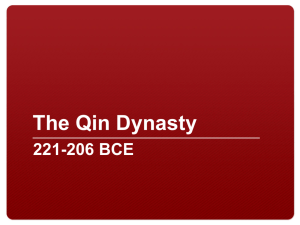

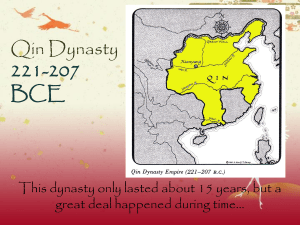
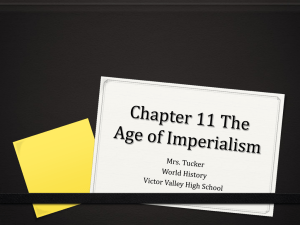

![Close Reading-revision[2]](http://s2.studylib.net/store/data/005273180_1-79a8e9a0e6d7f93732c7547eff7c1abc-300x300.png)
